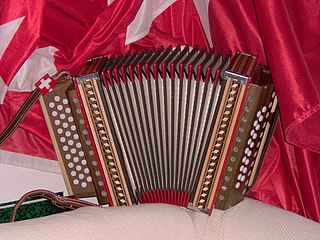
Accordions are a family of box-shaped musical instruments of the bellows-driven free-reed aerophone type, colloquially referred to as a squeezebox. A person who plays the accordion is an accordionist. The concertina, harmoneon and bandoneón are related. The harmonium and American reed organ are in the same family, but are typically larger than an accordion and sit on a surface or the floor.

The bassoon is a woodwind instrument in the double reed family, which plays in the tenor and bass ranges. It is composed of six pieces, and is usually made of wood. It is known for its distinctive tone color, wide range, versatility, and virtuosity. It is a non-transposing instrument and typically its music is written in the bass and tenor clefs, and sometimes in the treble. There are two forms of modern bassoon: the Buffet and Heckel systems. It is typically played while sitting using a seat strap, but can be played while standing if the player has a harness to hold the instrument. Sound is produced by rolling both lips over the reed and blowing direct air pressure to cause the reed to vibrate. Its fingering system can be quite complex when compared to those of other instruments. Appearing in its modern form in the 19th century, the bassoon figures prominently in orchestral, concert band, and chamber music literature, and is occasionally heard in pop, rock, and jazz settings as well. One who plays a bassoon is called a bassoonist.

A concertina is a free-reed musical instrument, like the various accordions and the harmonica. It consists of expanding and contracting bellows, with buttons usually on both ends, unlike accordion buttons, which are on the front.

The uilleann pipes are the characteristic national bagpipe of Ireland. Earlier known in English as "union pipes", their current name is a partial translation of the Irish language terms píobaí uilleann, from their method of inflation. There is no historical record of the name or use of the term uilleann pipes before the 20th century. It was an invention of Grattan Flood and the name stuck. People mistook the term 'union' to refer to the 1800 Act of Union; this is incorrect as Breandán Breathnach points out that a poem published in 1796 uses the term 'union'.

A bansuri is an ancient side blown flute originating from the Indian subcontinent. It is an aerophone produced from bamboo and metal like material used in Hindustani classical music. It is referred to as nadi and tunava in the Rigveda and other Vedic texts of Hinduism. Its importance and operation is discussed in the Sanskrit text Natya Shastra.

Fingerstyle guitar is the technique of playing the guitar or bass guitar by plucking the strings directly with the fingertips, fingernails, or picks attached to fingers, as opposed to flatpicking. The term "fingerstyle" is something of a misnomer, since it is present in several different genres and styles of music—but mostly, because it involves a completely different technique, not just a "style" of playing, especially for the guitarist's picking/plucking hand. The term is often used synonymously with fingerpicking except in classical guitar circles, although fingerpicking can also refer to a specific tradition of folk, blues and country guitar playing in the US. The terms "fingerstyle" and "fingerpicking" also applied to similar string instruments such as the banjo.

A Chemnitzer concertina is a musical instrument of the hand-held bellows-driven free-reed category, sometimes called squeezeboxes. The Chemnitzer concertina is most closely related to the bandoneón, more distantly to the other concertinas, and accordions.

A button accordion is a type of accordion on which the melody-side keyboard consists of a series of buttons. This differs from the piano accordion, which has piano-style keys. Erich von Hornbostel and Curt Sachs categorize it as a free reed aerophone in their classification of instruments, published in 1914. The sound from the instrument is produced by the vibration of air in reeds. Button accordions of various types are particularly common in European countries and countries where European people settled. The button accordion is often confused with the concertina; the button accordion's buttons are on the front of the instrument, where as the concertina's are on the sides and pushed in parallel with the bellows.

The Flutina is an early precursor to the diatonic button accordion, having one or two rows of treble buttons, which are configured to have the tonic of the scale, on the "draw" of the bellows. There is usually no bass keyboard: the left hand operates an air valve. A rocker switch, called a "bascule d'harmonie" is in the front of the keyboard. When this switch is thumb activated, it would open up a pallet (a pad that covers a tone hole, at the other end of the key button, for a simple Tonic/Dominant drone: Tonic on the draw and Dominant on the press, e.g. Tonic notes C/g, and Dominant G/d, without any major or minor thirds.

A melodeon or diatonic button accordion is a member of the free-reed aerophone family of musical instruments. It is a type of button accordion on which the melody-side keyboard contains one or more rows of buttons, with each row producing the notes of a single diatonic scale. The buttons on the bass-side keyboard are most commonly arranged in pairs, with one button of a pair sounding the fundamental of a chord and the other the corresponding major triad.
William "Merry" Kimber, was an English Anglo concertina player and Morris dancer who played a key role in the twentieth century revival of Morris Dancing, a form of traditional English folk dancing. He was famous both for his concertina playing and for his fine, upright dancing, such that in his day he was presented in the highest circles of society.

The Schwyzerörgeli is a type of diatonic button accordion used in Swiss folk music. The name derives from the town/canton of Schwyz where it was developed. Örgeli is the diminutive form of the word Orgel (organ). Outside of Switzerland the instrument is not well known and is hard to find.

Noel Hill is an Irish concertina player from County Clare who has had great influence developing the modern playing style of the Irish concertina, as a performer and educator.

Irish traditional music is a genre of folk music that developed in Ireland.

The Anglo or Anglo-German concertina is a member of the concertina family of free-reed instruments.

The Duet concertina is a family of concertinas, distinguished by being unisonoric and by having their lower notes on the left and higher on the right.

Carl Friedrich Uhlig (1789–1874) was a German luthier, known for inventing the German family of concertinas, from which are descended variants such as the bandoneón, Carlsfelder concertina, and Chemnitzer concertina.
The Carlsfelder concertina is a member of the German concertina family developed by Carl F. Zimmerman, based on the earlier Chemnitzer concertina of Carl Friedrich Uhlig. Zimmerman, a native of Carsfeld, Saxony, unveiled his instrument at the 1849 Industrial Exhibition in Paris, the 1851 London Industrial Exposition, and the 1853 Exhibition of the Industry of All Nations in New York. Zimmerman expanded on Uhlig's early 1- and 2-row square concertinas, developing a 3-row chromatic bisonoric instrument, eventually selling his business to instrument maker Ernst Louis Arnold and emigrating to the United States, where he later became famous for his string instrument invention, the autoharp.
John Hill Maccann, or Professor Maccann was a concertina player and designer from Plymouth, England. In 1884, Maccann patented a new design of Duet concertina, which became the first successful and most widely accepted layout of that instrument. Maccann's layout was a refinement of the earlier "Duette" system developed by Charles Wheatstone, inventor of the concertina. Initially called the "New Chromatic Duet English Concertina", it was to later be called simply the "Maccann system".

















